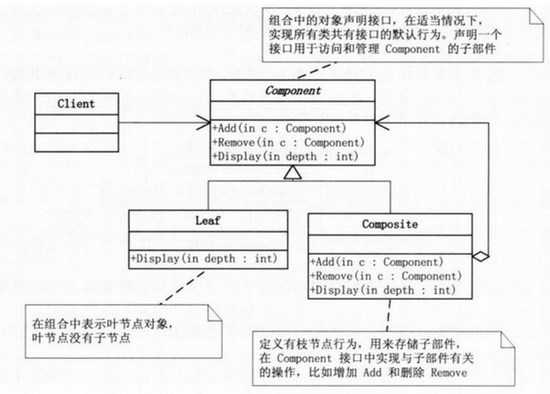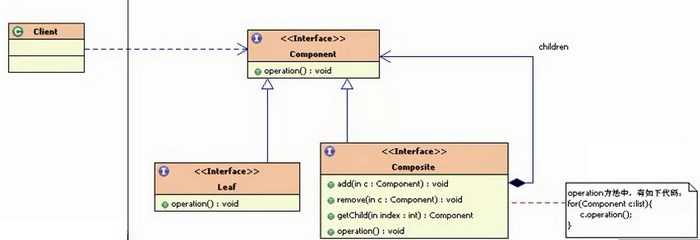标签:其他 port super 大话设计模式 img log junit word plain
一、组合模式介绍
组合模式:将对象组合成树形结构以表示:部分--整体 的层次结构。组合模式使得用户对单个对象和组合对象的使用具有一致性。
java中的组合是指:在A类里定义一个B类的引用,A拥有了B,叫组合。只是单纯的组合而已,而不是一种设计模式。
组合和组合模式不是一回事!
基本上见到的树形结构都使用到了组合模式。
组合模式结构图:

组合模式中有几个核心的部分:
Leaf(叶子):表示该节点下面没有其他子节点了,就称为叶子
Compostie(容器构件):容器构件,该节点下还有其他子节点,理解为一个容器,里面包含了其他子节点。就叫做容器构件
Component(抽象构件):抽象构件中定义了叶子和容器构件的共同点。比如,有公共的添加删除叶子功能,有显示节点功能。
例如:Windows中的文件管理

二、组合模式代码实现
首先,定义一个抽象的Component。提供一系列的公共接口
|
1
2
3
4
5
6
7
8
9
10
11
|
//Component(抽象构件):抽象构件中定义了叶子和容器构件的共同点。比如,有公共的添加删除叶子功能,有显示节点功能。public abstract class Component { protected String name; public Component(String name) { super(); this.name = name; } public abstract void add(Component c); public abstract void remove(Component c); public abstract void display(int depth);} |
然后定义具体的叶子节点,和容器节点
定义叶子节点,由于叶子节点中没有子节点了,所以不需要add和remove的具体实现
|
1
2
3
4
5
6
7
8
9
10
11
12
13
14
15
16
17
18
19
20
21
22
|
//表示该节点下面没有其他子节点了,就称为叶子public class Leaf extends Component { public Leaf(String name) { super(name); } @Override public void add(Component c) { System.out.println("leaf no add"); } @Override public void remove(Component c) { System.out.println("leaf no remove"); } @Override public void display(int depth) { StringBuffer sb = new StringBuffer("-"); for (int i = 0; i <= depth; i++) { sb.append("-"); } System.out.println(sb.toString()+name); }} |
再定义一个容器节点
|
1
2
3
4
5
6
7
8
9
10
11
12
13
14
15
16
17
18
19
20
21
22
23
24
25
26
27
28
29
|
import java.util.ArrayList;import java.util.List;//容器构件,该节点下还有其他子节点,理解为一个容器,里面包含了其他子节点。就叫做容器构件public class Composite extends Component{ private List<Component> children = new ArrayList<Component>(); public Composite(String name) { super(name); } @Override public void add(Component c) { children.add(c); } @Override public void remove(Component c) { children.remove(c); } @Override public void display(int depth) { StringBuffer sb = new StringBuffer("-"); for (int i = 0; i <= depth; i++) { sb.append("-"); } System.out.println(sb.toString()+name); for (Component com : children) { com.display(depth + 2); } }} |
最后客户端测试代码:添加一个树形结构
|
1
2
3
4
5
6
7
8
9
10
11
12
13
14
15
16
17
18
19
20
21
|
public static void main(String[] args) { Composite root = new Composite("root"); root.add(new Leaf("Leaf A")); root.add(new Leaf("Leaf B")); Composite comp = new Composite("Composite X"); comp.add(new Leaf("Leaf XA")); comp.add(new Leaf("Leaf XB")); root.add(comp); Composite comp2 = new Composite("Composite XY"); comp2.add(new Leaf("Leaf XYA")); comp2.add(new Leaf("Leaf XYB")); comp.add(comp2); root.add(new Leaf("Leaf C")); Leaf leaf = new Leaf("Leaf D"); root.add(leaf);// root.remove(leaf);//这里可以删除某节点 root.display(1);} |
打印结果如下:
---root
-----Leaf A
-----Leaf B
-----Composite X
-------Leaf XA
-------Leaf XB
-------Composite XY
---------Leaf XYA
---------Leaf XYB
-----Leaf C
-----Leaf D
三、总结
开发中应用场景:
操作系统中的资源管理器
GUI中的容器层次图
XML文件解析
OA系统中,组织结构的处理
Junit单元测试框架
参考资料:
大话设计模式(带目录完整版).pdf
HEAD_FIRST设计模式(中文版).pdf
尚学堂_高淇_java300集最全视频教程_【GOF23设计模式】
标签:其他 port super 大话设计模式 img log junit word plain
原文地址:http://www.cnblogs.com/cxxjohnson/p/6403844.html